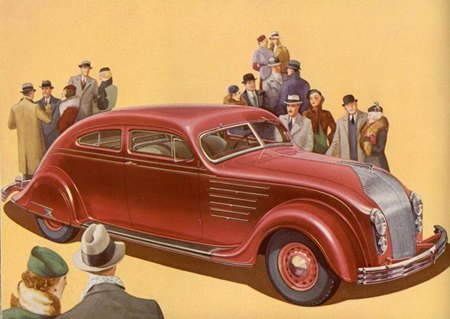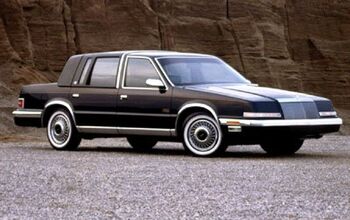Chrysler Suicide Watch 29: The Early Attempts, Pt. 1

Suicidal tendencies can be pathological, inevitably recurring. Chrysler’s current self-destructive phase, as chronicled by TTAC, is hardly its first. From its very beginnings, the patient has suffered from symptoms of bi-polar syndrome. Chrysler’s biography is a nothing less than a roller coaster ride of giddy highs punctuated by disastrous crashes and self mutilation.
Chrysler’s birth and euphoric immediate success is unparalleled in automotive history. Walter P. Chrysler had a brilliant career in the early automobile business, turning several ailing manufacturers into successes. By 1919, he’d earned $10m ($130m in today’s money) from three year’s work transforming Buick into GM’s early powerhouse.
In 1924, whilst running Maxwell, Chrysler launched his eponymous line. The cars sported a perfect blend of advanced engineering and style. It was a home run that catapulted Chrysler to number four out of a crowded field of 49 domestic manufacturers. The subsequent launches of low-price Plymouth and upper-mid priced DeSoto, and the purchase of mid-priced Dodge, firmly established Chrysler as a charter member of the Big Three.
Chrysler’s first crisis came in 1934, with the failure of the advanced Airflow. The model adopted the latest aerodynamic principles. The company also repositioned the engine and body further forward on the frame (foreshadowing “cab-forward”), delivering major advances in comfort, quietness and handling. While similarly avant-garde vehicles found favor in Europe, the Airflow’s startlingly blunt “waterfall” front end styling was too radical for America’s more conservative taste.
The American car buyer's wholesale rejection of the Airflow taught Chrysler (and GM and Ford) a painful lasting lesson: avoid the risks of extreme innovation. The fiasco helped shape Detroit’s enduring elevation of popular style over genuine innovation.
Chrysler revived, and made enormous profits during the WWII era. But the development of the critical all-new 1949 models was haunted by Chrysler’s lingering Airflow insecurities. Whereas GM and Ford confidently introduced longer and lower models designed to knock the socks off of exuberant post-was buyers, Chrysler President P. T. Keller insisted on tall, boxy and boring cars– specifically designed so that a man’s fedora wouldn’t be knocked off upon entering.
In that post-war buyer’s frenzy, Keller’s stolid tanks sold well enough– initially. By the early fifties, Americans were in the mood for more: horsepower, automatics, power steering and brakes, style and flash. Unlike Chevy and Ford, Plymouth offered none of those; the market punished it unmercifully. In 1954, Plymouth was kicked out of its long-established number three spot by Buick, and dropped to number five behind Pontiac. The mood pendulum had swung too far; it was due for an (over) correction.
Chrysler hired designer Virgil Exner to inject vitality into the company’s products. The 1955’s were an improvement. The radical 1957’s were set to be the great leap forward (“suddenly it’s 1960!”). But in the rush to revolutionize, the dramatically finned ‘57’s suffered from atrocious build quality. Water and dust leaks were notorious. Upholstery split. Springs came up through seats. And the cars started rusting on the dealer lots.
The flashy new product sold, but word spread quickly. Plymouth’s 1958 sales plunged by no less than 41 percent. Despite a rep for engineering prowess, Chrysler would have to dodge a reputation for spotty build quality from then on, deserved or not.
Chrysler nursed itself to health once more, only to be deeply wounded by a staggeringly idiotic act of self-mutilation.
In 1960, Chrysler president William Newberg heard a rumor at a cocktail party that Chevrolet was working on a dramatically smaller 1962 model (the compact Chevy II). In a colossal blunder, Newburg assumed this downsizing rumor referred to ALL the full-sized Chevrolets. Newberg immediately killed development of Chrysler’s best-selling full-size 1962 Plymouths and Dodges, and initiated a crash program for substantially smaller replacements.
In what some historians consider a calculated act of revenge for this folly, chief stylist Exner responded by creating bizarrely-styled 1962 Dodges and Plymouths. When these ugly, truncated cars were first shown to dealers at a convention, they created an uproar. Twenty dealers cancelled their franchises on the spot. Plymouth crashed to ninth place, while GM picked up the pieces, swelling its market share to an all-time peak of 52 percent.
Newberg was shown the door. Chrysler hastily restyled the ‘63’s, and went on to enjoy a relatively long spell of good health. From the mid-sixties through 1974 the company thrived, in part thanks to its successful performance image. But with a portfolio [literally] heavy with large rear wheel-drive cars, lacking the foresight, will (and capital) to invest in new efficient compacts, Chrysler was flattened by the one-two punch of the energy crises.
By 1979, the Pentastar was back on the critical list, saved from bankruptcy by taxpayer funded life-support in the form of a $1.5 billion bail-out package of government guaranteed loans.

More by Paul Niedermeyer
Latest Car Reviews
Read moreLatest Product Reviews
Read moreRecent Comments
- Akear The malibu still outsells all GM EVs combinedMalibu -150,000GM EV's - 75,000Maybe this represents how execrable GM EVs really are. Barra should have resigned years ago,
- Fred Short term bean counters give up the market and long term players gain shares.
- KOKing I thought they quit making it 3yrs ago so... no?
- TheEndlessEnigma Hybrids and PHEVs make sense, EV's do not.
- Ajla My understanding is that the 5 and 7-Series cater almost exclusively to the Chinese market and they sell them here just so they don't look weak against Mercedes and Audi.







































Comments
Join the conversation
The botched 1962 redesign luckily didn't extend to the entire corporate line; Chrysler kept the 1961 look sans fins, and a rebadged Chrysler was rushed to Dodge dealers mid-year as the 880. The way for this was eased by the demise of DeSoto.
My mother still talks about grandpa's 1958 Desoto. Push button drive. Stylish. Innovative. Drove from Wisconsin to Georgia and back without a hiccup several times (pre-interstate era....a six day trip each way) with the whole family packed in.